A Beginner Guide For Artists
There are several ways that I have sold thousands of dollars of art on Facebook but they all hinge on the very basics. You first have to be known, liked and trusted! With over 2 billion eager monthly users ready to discover and invest in your artistic brilliance don’t fall for the idea that the market is saturated. The hitch is, most artists miss out on this great opportunity because they struggle with exposure, building a customer base, and promoting their art on Facebook. But essentially, selling your art on Facebook is simpler than you think. It boils down to three steps:
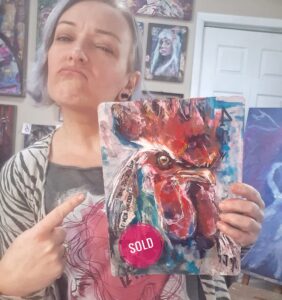
The Essentials: Build, Grow, and Promote
Selling art on Facebook is an exciting journey, revolving around three pivotal steps:
- Build Your Artist Page
- Grow Your Following
- Promote Your Art
Don’t overcomplicate things in the beginning. You first need to start your business, grow your business and yes, that dreaded final step – promote your business. People need to know, like and trust you before they’ll buy art from you. Let’s dive in to the process, empowering you to navigate the Facebook art scene like a seasoned pro.
Step 1: Craft Your Professional Artist Page
It’s important to create a professional artist page in order to establish a credible and dedicated presence on Facebook. I for one, have both an Artist Page and a business page for the gallery which is important for several reasons:
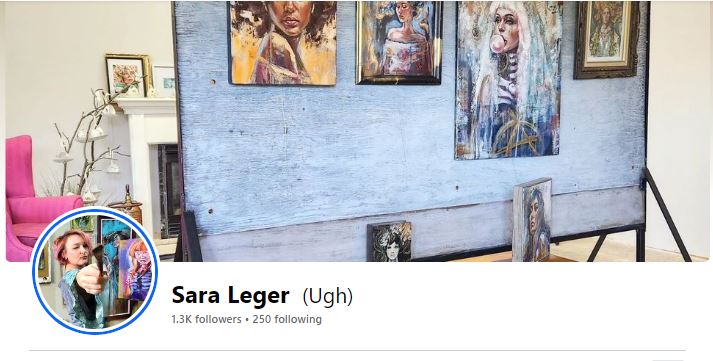
I very rarely add LIFE posts on my art page.
It’s 90% Art.
Professionalism and Trust
Having an Artist Page signals professionalism, instilling trust in potential buyers who can certainly be leery about online sales. An Artist Page signals that you take your craft seriously and are committed to showcasing your work in a dedicated space.
Centralized Platform: Your Artist Page serves as a focused space solely for your art. Unlike a personal profile, it avoids mixing personal and professional content, providing a streamline experience for art enthusiasts.
Brand Growth: Establishing a dedicated Artist Page accelerates the growth of your personal brand. It allows you to cultivate a distinct identity as an artist, separate from your personal life. Consistent branding makes it easier for people to recognize and connect with your work.
Adherence to Platform Rules: Utilizing an Artist Page ensures compliance with Facebook’s terms of service. Social media platforms often have specific guidelines regarding the promotion and sale of products, including art. By creating a separate Artist Page, you not only prevent limitations on exposure and sales but also enhances credibility with both buyers and the platform.
In the dynamic and competitive landscape of online art sales, credibility is a currency that holds a lot of value. Remember the three key factors involved in selling art on Facebook; potential customers need to know, like and trust you.
How to Craft Your Artist Page
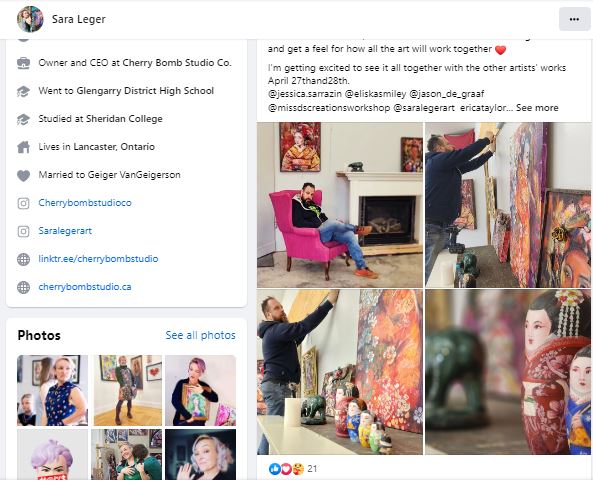
Don’t Be Afraid to Share Behind The Scenes. Show the Messy parts and unfinished parts.
- Visual Appeal: When crafting your Artist Page, it’s crucial to create a visually appealing and professional online presence. Utilize your image as the profile picture to add a personal touch, whether it’s a striking self-portrait or a captivating image of your workspace. Think of your cover image as a digital storefront.
- Example: Consider using a striking self-portrait or a captivating image of your workspace.
- Online Presence: Share your journey, influences, and the stories behind your creations. Also, be sure to regularly update folks to keep them engaged, and don’t forget to engage with them through comments and messages to foster a sense of community. Avoid neglecting essential details like contact information and links to your online store. ATT: Facebook doesn’t like you take the customer off the platform so do not add your links in the post.
PRO TIP: To work within Facebook’s guidelines, use a two-step approach. In your initial post, provide a teaser or description of the artwork without including external links. Encourage engagement and expressions of interest from your audience. Then, respond to comments or direct messages, helping interested buyers to learn more or to give them the link. This way, you maintain engagement on the platform while still directing potential customers to your artwork.
- Fill The About Section: Craft a brief yet compelling description of your Artist Page, capturing the essence of who you are and the art you create. Remember that people buy from people so be authentic. Write a short but captivating bio that gives a sense of your artistic journey, highlights influences, and shares the stories behind your creations.
Do: Regularly update your Artist Page with new artwork and engage with your audience through comments and messages.
Don’t: Neglect to include important details like contact information and links to your online store.
Congratulations! You’ve laid the foundation for a professional Artist Page that speaks volumes.
Step 2: Grow Your Follower Base
I haven’t quite got this growing thing down. I have an artist page but is it thriving? All I know, is you need a squad of art enthusiasts. Here are three battle-tested strategies to gather your creative tribe:
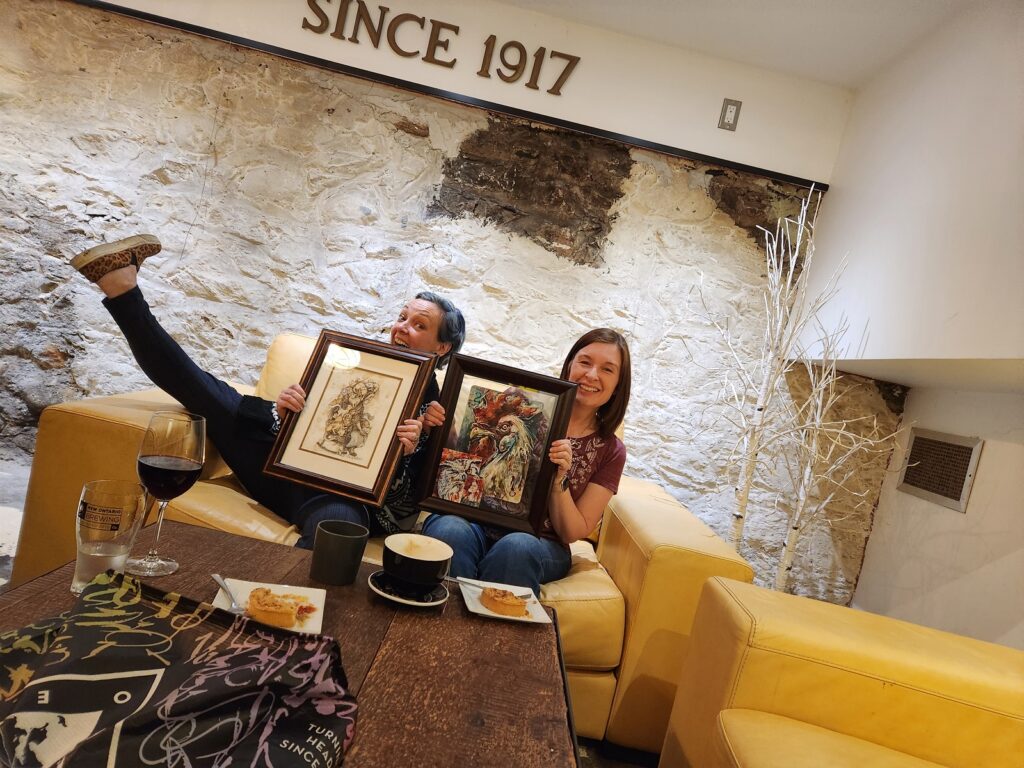
Meeting People In Person IS Still The Best!
By far the best way I have ever sold my art was in person. Knowing the human being and enjoying each others company can’t be beat.
- Engaging Content: First and foremost, provide value for your audience by posting educational, inspiring and engaging content that sparks conversation, whether it’s through thought-provoking posts, captivating photos, or mesmerizing videos. For instance, share your creative process, your struggle or highlight the intricate details of your artworks.
- Strategic Hashtags: Connect your content with relevant hashtags for broader visibility but don’t rely on them. As the algorithm gets smarter the quality of the post are far more important.
- Collaborate and Tag: Consider collaborating on a themed art project with another artist and cross-promote each other’s works. Enhance this collaboration by encouraging your followers to share the project in their stories, creating a dynamic and interactive experience that expands your reach and fosters a sense of community engagement. This approach not only widens your audience but also strengthens connections within the art community.
Do: Encourage your followers to share your content, expanding your reach organically.
Don’t: Overwhelm your audience with excessive promotional posts; maintain a balance between promotion and engagement.
Step 3: Showcase and Promote Your Art
Buckle up artists It’s about to get uncomfortable. To successfully sell your art, you must embrace the fact that promoting your work is a necessary and positive step in the process. Often, artists shy away from this part of their art business, fearing it may come across as egotistical. However, when we go back to the fundamental principles of ‘know, like, and trust,’ it‘s clear that people need to first KNOW you exist. I’ll offer you up some suggestions here.
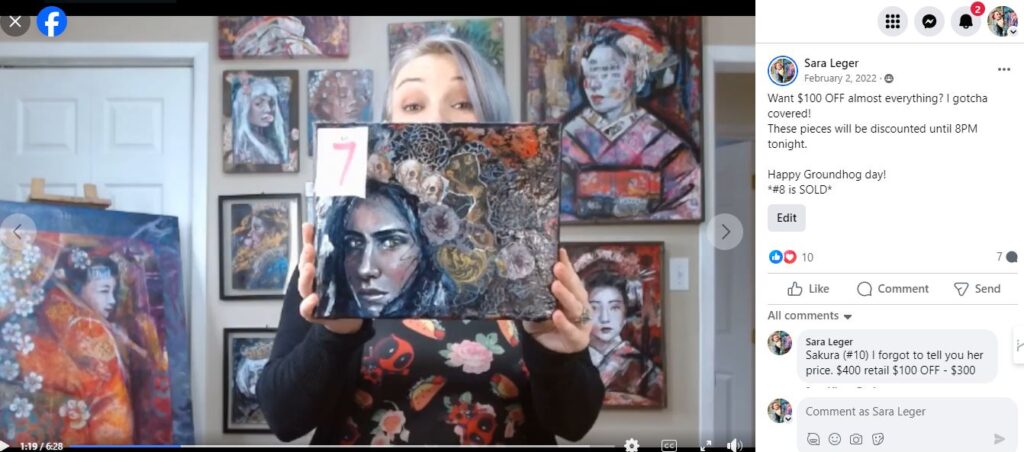
3 Day Studio Sale On Facebook
Back in 2022 I had a studio sale. Each day had a slightly different theme. I sold over a thousand dollars! At the time that was a lot considering each piece was around $200 to $400.
Showcasing Your Artwork.
Efficiently showcasing your art on Facebook goes beyond posting images. Use the Stories, Reels, Live, and even 3D Photos for a dynamic presentation. Engage your audience with behind-the-scenes content, virtual art shows, and live painting sessions. Your art is not just an image; it’s a story waiting to be told. Leverage every Facebook feature to narrate the tale behind each masterpiece, creating a richer connection with your audience.
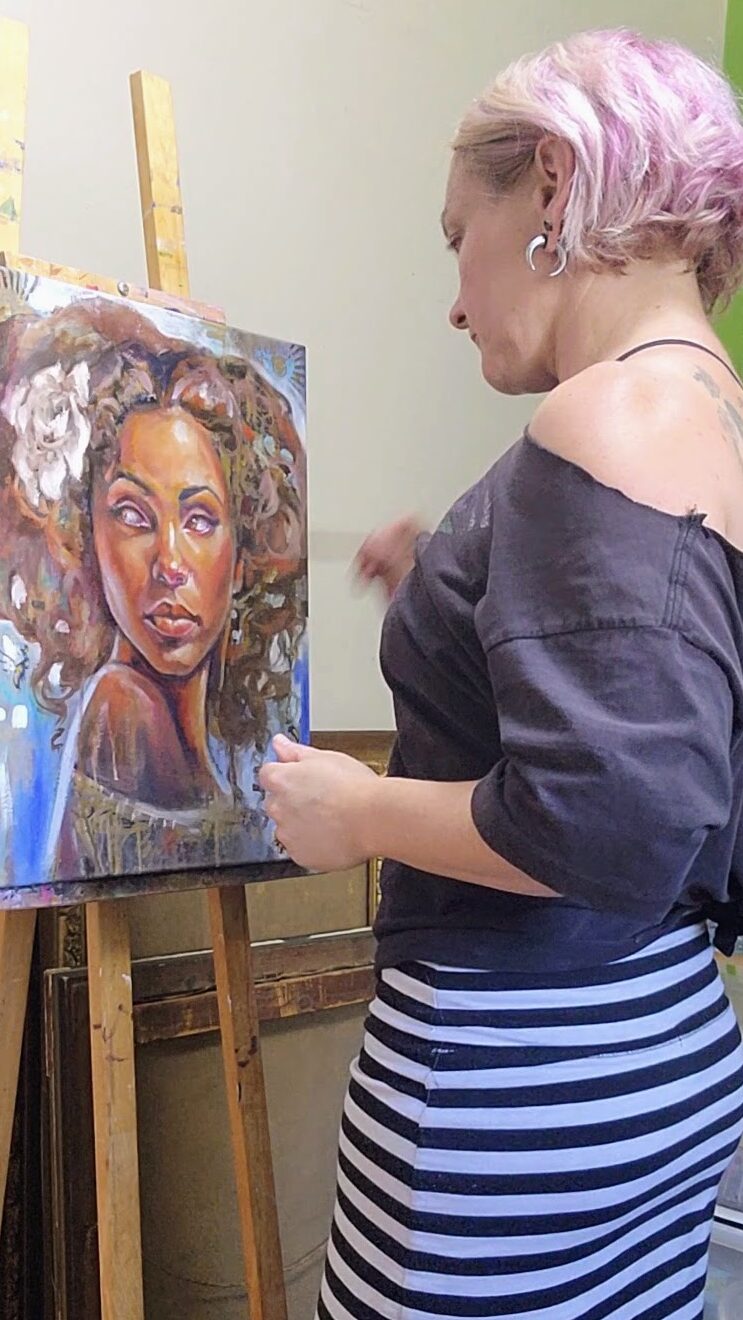
Building an Engaged Audience and Understanding Post Reach. The key to successful art sales on Facebook lies in building an engaged audience. Encourage your network to like and follow your page, and regularly post engaging content to improve post reach. Collaborate with other artists and art-related pages to broaden your exposure.
Engagement is the heartbeat of your Facebook presence. Don’t just post and ghost. Establish a meaningful connection with your audience through comments, encouraging them to follow your artistic journey and let them know when your art is for sale IN A GENUINE WAY. Actually engage with the humans who follow you and don’t just treat them like a transaction. Share stories related to your creations, let them get to know the human behind the art.
People buy from people not businesses.
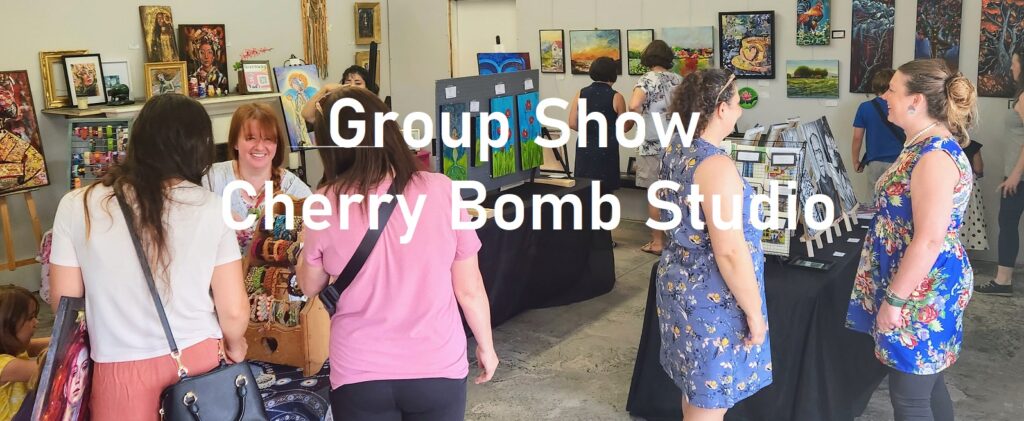
Leveraging Facebook Reels. Explore the potential of Facebook Reels, a feature gaining traction. Short, engaging videos can boost engagement, providing a cost-effective way to reach your audience. Think of them as short FREE commercials or backstage passes. People find us artists interesting – so I hear.
Video content lately has been the currency of social media which I am not exactly thrilled about. Try making some videos (honestly I kind of hate making them), showcasing not just your finished art but the mesmerizing process behind it. If you absolutely loath the idea then don’t do it.
Promoting and Selling Art.
The best thing you can do is to engage with your community. Treat them like the wonderful humans they are. They DO NOT HAVE TO BE THERE ON YOUR PAGE FOLLOWING YOU. Engage with your community, encourage reviews, run contests but mostly tell great stories and let them in on your life as an artist and your art. Promotion is an art in itself.
Using Facebook Groups and Events
Facebook Groups and Events are great tools for artists. Join relevant groups to share your work, gain feedback, and sell art. Create and promote events such as art shows and workshops to interact with potential buyers in real-time.
Community is the backbone of art. Join or create your own Facebook Group, share your artistic journey, seek inspiration, and let your art be a focal point in events that bring art lovers together.
Leveraging Facebook Business Suite for Insights and Analytics
Maximize Facebook Business Suite to track engagement, understand your audience, manage messages, and monitor advertising performance. Regularly analyze metrics to refine your strategy for optimal art sales.
*You can dive in deeper if you want but honestly, I have stepped away from getting too deep in the weeds for my own sanity. But you can use insights to understand what resonates with your audience, when they are most active, and tailor your artistic journey to meet their expectations.
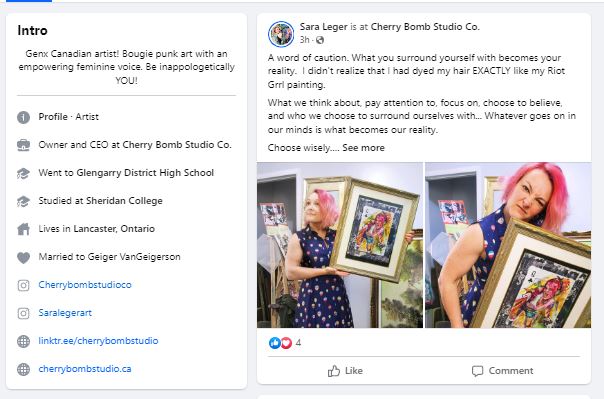
My About Section Is All Filled Out
This post isn’t about selling. Just a behinds the scenes revelation. I didn’t realize my hair was the same colour. Your posts should not be all about sales, sales, sales. No one like that.
Dos and Don’ts When Selling Art on Facebook
Dos:
Do Treat Everyone Like A Human Being And Not Just A Transaction!
- Engage with your audience through comments and messages.
- Post consistently to keep your audience interested.
- Explore collaborations with other artists and art-related pages.
- Utilize the power of storytelling in your art posts.
- Participate in relevant Facebook Groups to expand your reach.
Don’ts:
Thou Shalt Not Post And Ghost!
- Spam your audience with excessive promotional content.
- Neglect responding to comments and messages promptly.
- Compromise on the quality of your images and content.
- Violate Facebook’s rules and guidelines.
- Solely focus on selling; balance promotion with genuine engagement.
Final Word on Sales
Great salespeople are relationship builders who provide value and help their customers win. – Jeffrey Gitomer
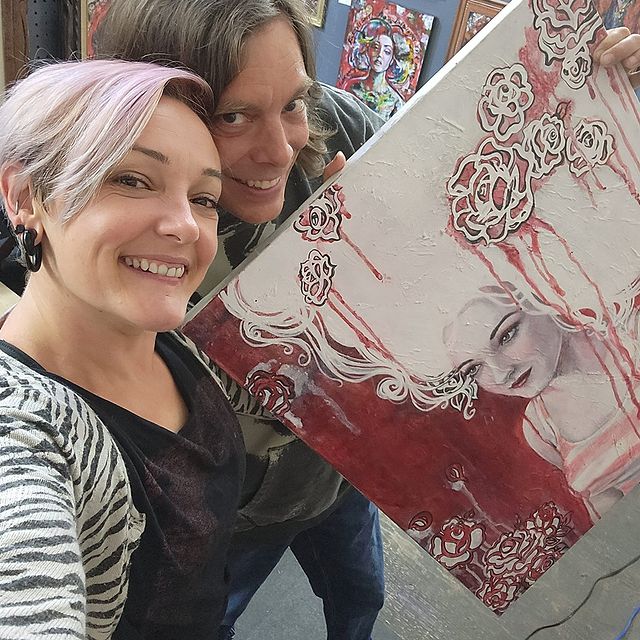
Selling your art on Facebook goes beyond making pretty art; it’s a relationship built on knowing, liking and trusting the person on the other side of the screen.
By establishing a professional Artist Page, building following of like minded people who resonate with your work, and authentically promoting your art, you’ll can sell your art on Facebook but fundamentally it comes down to building relationships. It’s a long game but it’s worth it.
Your Facebook business page is the gateway to your artistic world. Treat it as a reflection of your brand, allowing visitors to dive into your creative universe effortlessly.
